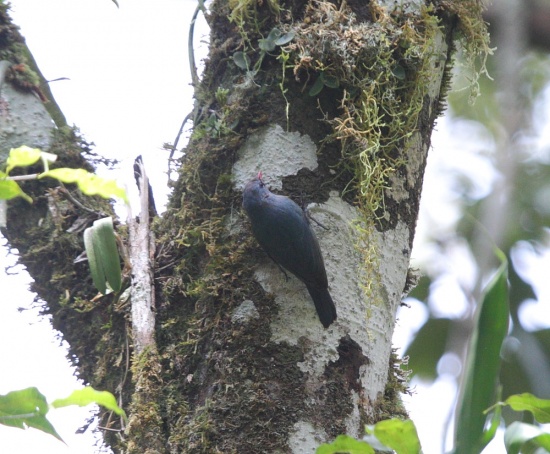Alternative Names: Coral-billed Nuthatch; Coralbill; Madagascar Nuthatch
- Hypositta corallirostris
Identification
13 - 14cm. A small, highly distinctive vanga, the claw of the first toe is elongated (20mm):
Male
- Mid-blue plumage
- Black lower forehead, lores and chin
- Variable pale buff on vent
- Dark brown eye
- Bright orange-red bill
- Dark grey legs
Female
- Brownish-green head, lacking black eyestripe
- Buffy forecrown
- Blue hindcronw, mantle, scapulars, upperwing-coverts and tail
- Buffish rump, chin, breast and belly
- Bill duller red
Juveniles are similar to females.
Distribution
Endemic to north and east Madagascar.
Locally common in its restricted range.
Taxonomy
This is a monotypic species.
The described form perdita, sometimes accepted as full species (Bluntschli's Vanga), is based on two juveniles found in a museum drawer. It might be just aberrant examples of this species.
Habitat
Evergreen humid forest from sea-level up to 1800m.
Behaviour
Feeds on small invertebrates and small vertebrates.
Climbs tree trunks like a nuthatch, searching for food on bark.
Usually seen in groups of two or three birds, almost always in mixed-species flocks with other vangas, Madagascar Cuckooshrike, Malagasy Bulbul, Common Newtonia or Malagasy Paradise-Flycatcher.
Breeding season probably from August to September. One described nest was a cup made from live and dead mosses, attached to a tree trunk. No other information about breeding.
A sedentary species.
References
- Clements, JF. 2009. The Clements Checklist of Birds of the World. 6th ed., with updates to December 2009. Ithaca: Cornell Univ. Press. ISBN 978-0801445019.
- Del Hoyo, J, A Elliott, and D Christie, eds. 2009. Handbook of the Birds of the World. Volume 14: Bush-shrikes to Old World Sparrows. Barcelona: Lynx Edicions. ISBN 978-8496553507
Recommended Citation
- BirdForum Opus contributors. (2024) Nuthatch-Vanga. In: BirdForum, the forum for wild birds and birding. Retrieved 8 June 2024 from https://www.birdforum.net/opus/Nuthatch-Vanga




